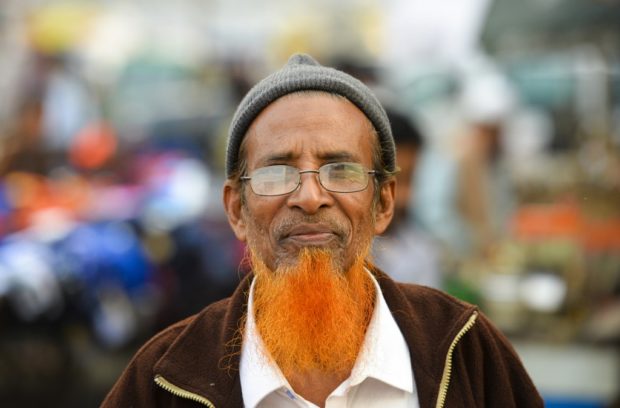
In this photo taken on December 24, 2018, henna enthusiast Eklas Ahmed with a henna-dyed beard poses for a photo in Dhaka. – From shades of startling red to hues of vivid tangerine, brightly coloured beards have become a fashion statement on the streets of Bangladesh capital Dhaka. (Photo by MUNIR UZ ZAMAN / AFP) / TO GO WITH Bangladesh fashion beards,FOCUS by Shafiqul ALAM
DHAKA, Bangladesh — From shades of startling red to hues of vivid tangerine, brightly colored beards have become a fashion statement on the streets of Bangladesh capital Dhaka.
Facial hair of sunset tones is now the go-to look for older men wanting to take off the years, with an array of henna options available to the style-conscious.
“I have been using it on my hair for the last two months. I like it,” says Mahbubul Bashar, in his 50s, whose smile reflected his joy at his new look.
Abul Mia, a 60-year-old porter at a local vegetable market, agrees that the vibrant coloring can be transformative.
“I love it. My family says I look a lot younger and handsome,” he adds.
Henna dye
While henna has been used widely in the country for decades, it has reached new heights of popularity. It is now virtually impossible to walk down a street in a Bangladesh city without seeing a colored beard.
Orange hair—whether it’s beards, moustaches or on heads—is everywhere, thanks to the popularity of the colored dye produced by the flowering henna plant.
“Putting henna on has become a fashion choice in recent years for elder men,” confirms Didarul Dipu, head fashion journalist at Canvas magazine.
“The powder is easily found in neighborhood stores and easy to put on,” he adds.
But the quest for youth is not the only reason more and more Dhaka barbers are adding beard and hair coloring to their services.
Top imams also increasingly use henna powder color in what experts say is a move to prove their Muslim credentials as some religious texts say the prophet Muhammad dyed his hair.
In Bangladesh, most of the population of 168 million is Muslim.
“I heard from clerics that the prophet Muhammad used henna on his beard. I am just following,” says Dhaka resident Abu Taher.
Henna has long been a tradition at South Asian weddings. Brides and grooms use henna paste to trace intricate patterns on their hands for wedding parties.
It has also long been used in Muslim communities in Asia and the Middle East for beards.
Previously, aficionados created the dye by crushing henna leaves to form a paste. It was messy and time-consuming but modern henna powder is far more user-friendly.
Taher, who goes by one name, believes the dye has given his beard added vigor.
“Look at this growth. Isn’t it strong?” he exclaims, pointing to his chin.